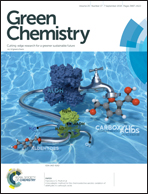A surface plasmon-enhanced nanozyme-based fenton process for visible-light-driven aqueous ammonia oxidation†
Abstract
By incorporating glucose oxidase-like activity and surface plasmon resonance (SPR) of Au nanoparticles (AuNPs), a novel nanozyme-Fenton system is designed, i.e., ultrasmall AuNPs and α-FeOOH microcrystals are grown on porous carbons for constructing a nanozyme-Fenton catalyst. AuNPs can catalytically oxidize glucose with oxygen for producing H2O2 (the crucial reagent in Fenton process) and gluconic acid (regulating the pH of micro-environment). Due to the SPR effect, the interaction between the glucose molecules and oscillating local electromagnetic fields contributes to the activation of the glucose molecules, promoting the reaction with O2 in close proximity, thus enhancing the production of H2O2. The heat released from AuNPs by absorbing light energy can increase the system temperature to the optimum condition of the enzymatic reaction. Hot electrons from plasmon-excited AuNPs promote charge separation at the Au/α-FeOOH interface, leading to efficient cycling of Fe3+/Fe2+. Besides, growing these α-FeOOH nanocrystals on the porous structures of carbon frameworks is beneficial for the electron transfer between the carbon and α-FeOOH, and this restricts the leaching of iron ions. This study can provide a novel path for the development of a Fenton-like reaction based on a photo-induced surface plasmon-enhanced nanozyme-Fenton catalyst to improve the ˙OH production efficiency.



 Please wait while we load your content...
Please wait while we load your content...